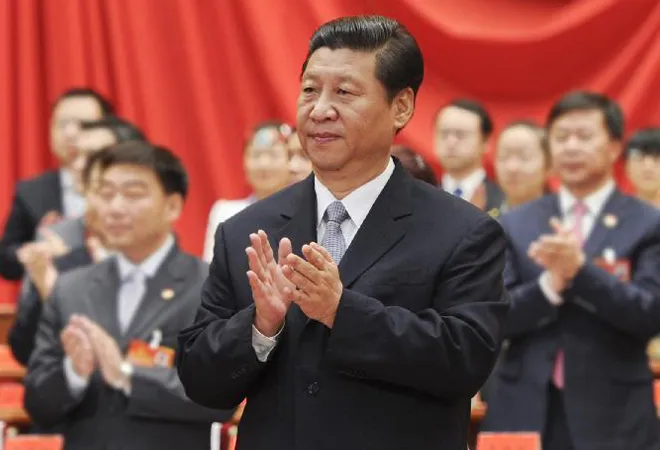
President Xi Jinping kicked off the Chinese Communist Party’s (CCP) National Congress, which charts its policy trajectory for the next five years and finalises its future leadership, with an address to the Party faithful for nearly 1 hour and 45 minutes.
This year, the CCP’s leadership conclave comes amidst a major strain on the Chinese economy with important segments like real estate, manufacturing, and retail bleeding either as a result of COVID-19 curbs or policy shifts. The International Monetary Fund’s World Economic Outlook, released in October, estimates China’s GDP growth at
3.2 percent this year; in contrast, India and ASEAN-5 are expected to post
6.8 percent and
5.3 percent growth respectively. There have been sporadic protests against curbs imposed due to the COVID-19 pandemic. Another worry is China’s relationship with the US, which has deteriorated due to the former’s close ties with Russia, its refusal to criticise Russia’s aggression in Ukraine, and its threat to mount an invasion of Taiwan. Many of these concerns, along with Xi’s “achievements” since he assumed office in 2012, resonated in his speech. In 2021, the Chinese government announced that as many as
100 million had been brought out of poverty, which Xi touted as a major victory. On the issue of Hong Kong, Xi expressed satisfaction that “patriots” were presiding over the island’s affairs, and its diplomatic corps was doing a stellar job of upholding the nation’s dignity.
Many of these concerns, along with Xi’s “achievements” since he assumed office in 2012, resonated in his speech. In 2021, the Chinese government announced that as many as 100 million had been brought out of poverty, which Xi touted as a major victory.
China’s response to the COVID-19 pandemic was to shutter down cities and initiate mass testing of the population, which has caused some dissent within the population.
Liang Wannian, chief of China’s Epidemic Response and Disposal Leading Group—a committee that operates under the National Health Commission—admitted that there was an anticipation of returning to life as it was before the pandemic, but admitted that there was no exit strategy in an interview to the state broadcaster ahead of the Congress. There have been nearly
1 million COVID cases in China since the start of the pandemic, which is around 0.07 percent of its population. According to China’s health officials, when compared with Western nations, both the rate of infection and total death toll (approximately 5,200) is low, but Liang expressed fears that in the absence of “better means of treatment”, abruptly discontinuing the policy could overwhelm the healthcare system and lead to more deaths. Nearly
90 percent of China’s population has been fully vaccinated against COVID as of mid-October and around 86.3 percent of those in the 60+ age group have also been vaccinated as of early October.
But given the CCP’s penchant of turning an adversity into an opportunity, Xi has sold China’s zero COVID-19 policy as prioritising the protection of lives of citizens. A recent article in
People’s Daily, the CCP’s mouthpiece, justified the continuation of the zero COVID-19 policy. The
article chided the approach of some nations that have “chosen to live with the virus” despite a huge death toll, contrasting it with China’s approach, which has “saved lives” but caused economic damage.
However, upon closer examination, the gloss around Xi’s accomplishments seems to be wearing off. The abrupt lockdowns necessitated by the zero COVID strategy have hit the poor and threaten to
jeopardise the gains of China’s poverty alleviation programme, which the CCP touted as a feat that had “not been accomplished in human history”. The authorities in provincial
Jilin recently started doling out 200 yuan (US$31.5) to low-income households and poor residents, along with vegetables and some medical supplies.
The state media’s portrayal of Xi as leading the campaign to fight the pandemic has tied him closely to China’s COVID-19 control efforts.
In 2022, more than 10 million students will graduate and the race for jobs is likely to get intense. This raises the prospects of high unemployment that may have a bearing on China’s growth in the long run. The findings of a study conducted by academics at Peking University revealed that China’s unemployment rate could reached the levels of 2020 under the pandemic prevention measures that are still in place. The research estimated the number of unemployed Chinese in mid-2020 could have been
92 million, which is nearly 12 percent of the working population. The state media’s portrayal of Xi as leading the campaign to fight the pandemic has tied him closely to China’s COVID-19 control efforts. Thus, any immediate relaxation after the Congress could contradict the claim that China’s stern response is intended at putting people’s lives and health first.
What does the future portend?
The decibel level of the audience applause on Xi’s pronouncements on Taiwan is, perhaps, a pointer to the direction of Cross-Straits relations and Sino-US relations. Xi assured the party and the people that he was up to the challenge of tackling the forces of separatism and foreign interference on the island. The CCP has showcased hard power after a visit to the island by US House Speaker Nancy Pelosi in August; Beijing sees the broadening of contacts between the American and Taiwanese leaderships as a chipping away of the notion of one-China and as a major violation of its sovereignty. Following which, the People’s Liberation Army (PLA) staged military exercises that was tantamount to a partial blockade and flew warships and aircraft with increasing regularity across the de-facto median line in the Taiwan Strait. In his work report, Xi promised to make utmost efforts to
unify Taiwan peacefully, but also reiterated that the Party retains the right to use force to bring it back to the fold. Additionally, Xi’s has pledged that the
complete reunification of China would see fruition soon, and that the Chinese military expedite its efforts to become a superior war machine that has the ability to win regional wars. The rhetoric on Taiwan, in conjunction with the exhortation to the PLA to ramp up its might, presents a possibility that Xi will place Taiwan on the front burner in his third term, which must worry the world community.
Xi’s has pledged that the complete reunification of China would see fruition soon, and that the Chinese military expedite its efforts to become a superior war machine that has the ability to win regional wars.
Techno-nationalism too featured in Xi’s address. Ahead of the Congress, the Biden administration has upped the ante on two key factors that played a role in China’s rise-- capital and technology. It has further
restricted China’s access to high-end semiconductors that have application in Artificial Intelligence, and also added more companies to a blacklist that bars US citizens from investing in them. In his address, Xi made repeated references to China’s scientific development in the field of space exploration, nuclear technology, medical breakthroughs, and ocean exploration
. China poured a record 2.79 trillion yuan (US$388 billion) into research and development in 2021, a rise of more than 14 percent from 2020. His thrust on China becoming more innovative and self-sufficient in the technological sphere is, thus, a response to the Biden administration’s actions.
To conclude, Xi paints a picture of the future as one replete with opportunity and danger as evidenced from his warning that
“external forces” could seek to “blackmail, contain and blockade” China. The sub-text is clear that it is under his stewardship that China has been able to come to grips with the problems and that it is his strong leadership that has been able to made a difference. However, one aspect that Xi has overlooked is the naming of a successor. A large country like China needs a defined line of succession, and any void can risk the chances of political tensions.
The views expressed above belong to the author(s). ORF research and analyses now available on Telegram! Click here to access our curated content — blogs, longforms and interviews.



 President Xi Jinping kicked off the Chinese Communist Party’s (CCP) National Congress, which charts its policy trajectory for the next five years and finalises its future leadership, with an address to the Party faithful for nearly 1 hour and 45 minutes.
This year, the CCP’s leadership conclave comes amidst a major strain on the Chinese economy with important segments like real estate, manufacturing, and retail bleeding either as a result of COVID-19 curbs or policy shifts. The International Monetary Fund’s World Economic Outlook, released in October, estimates China’s GDP growth at
President Xi Jinping kicked off the Chinese Communist Party’s (CCP) National Congress, which charts its policy trajectory for the next five years and finalises its future leadership, with an address to the Party faithful for nearly 1 hour and 45 minutes.
This year, the CCP’s leadership conclave comes amidst a major strain on the Chinese economy with important segments like real estate, manufacturing, and retail bleeding either as a result of COVID-19 curbs or policy shifts. The International Monetary Fund’s World Economic Outlook, released in October, estimates China’s GDP growth at  PREV
PREV


